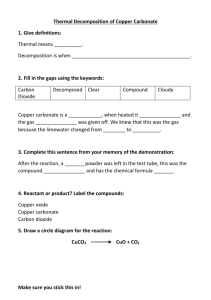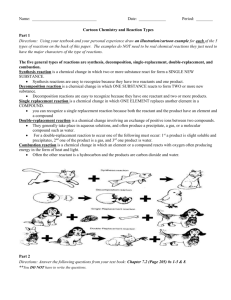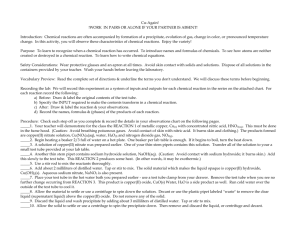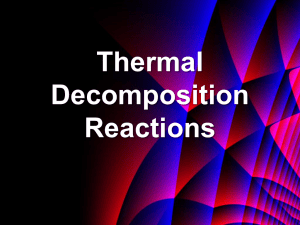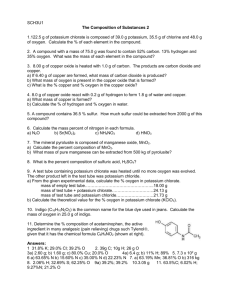Chemical Reactions Lab Directions
advertisement
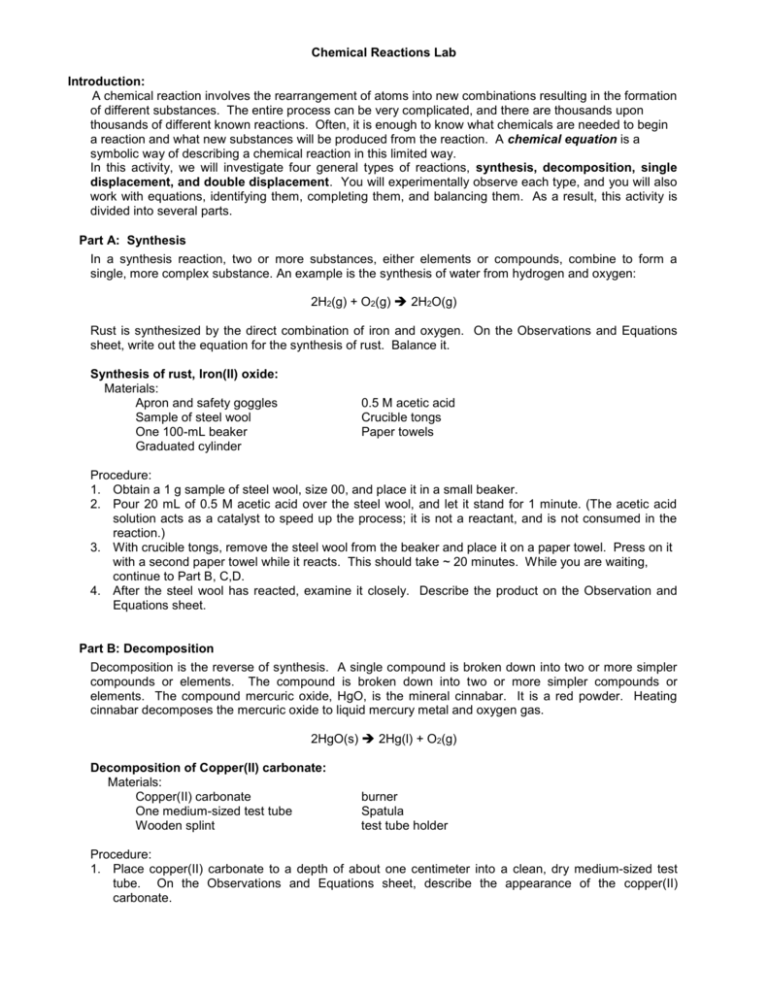
Chemical Reactions Lab Introduction: A chemical reaction involves the rearrangement of atoms into new combinations resulting in the formation of different substances. The entire process can be very complicated, and there are thousands upon thousands of different known reactions. Often, it is enough to know what chemicals are needed to begin a reaction and what new substances will be produced from the reaction. A chemical equation is a symbolic way of describing a chemical reaction in this limited way. In this activity, we will investigate four general types of reactions, synthesis, decomposition, single displacement, and double displacement. You will experimentally observe each type, and you will also work with equations, identifying them, completing them, and balancing them. As a result, this activity is divided into several parts. Part A: Synthesis In a synthesis reaction, two or more substances, either elements or compounds, combine to form a single, more complex substance. An example is the synthesis of water from hydrogen and oxygen: 2H2(g) + O2(g) 2H2O(g) Rust is synthesized by the direct combination of iron and oxygen. On the Observations and Equations sheet, write out the equation for the synthesis of rust. Balance it. Synthesis of rust, Iron(II) oxide: Materials: Apron and safety goggles Sample of steel wool One 100-mL beaker Graduated cylinder 0.5 M acetic acid Crucible tongs Paper towels Procedure: 1. Obtain a 1 g sample of steel wool, size 00, and place it in a small beaker. 2. Pour 20 mL of 0.5 M acetic acid over the steel wool, and let it stand for 1 minute. (The acetic acid solution acts as a catalyst to speed up the process; it is not a reactant, and is not consumed in the reaction.) 3. With crucible tongs, remove the steel wool from the beaker and place it on a paper towel. Press on it with a second paper towel while it reacts. This should take ~ 20 minutes. While you are waiting, continue to Part B, C,D. 4. After the steel wool has reacted, examine it closely. Describe the product on the Observation and Equations sheet. Part B: Decomposition Decomposition is the reverse of synthesis. A single compound is broken down into two or more simpler compounds or elements. The compound is broken down into two or more simpler compounds or elements. The compound mercuric oxide, HgO, is the mineral cinnabar. It is a red powder. Heating cinnabar decomposes the mercuric oxide to liquid mercury metal and oxygen gas. 2HgO(s) 2Hg(l) + O2(g) Decomposition of Copper(II) carbonate: Materials: Copper(II) carbonate One medium-sized test tube Wooden splint burner Spatula test tube holder Procedure: 1. Place copper(II) carbonate to a depth of about one centimeter into a clean, dry medium-sized test tube. On the Observations and Equations sheet, describe the appearance of the copper(II) carbonate. 2. Using test-tube holder, heat the copper(II) carbonate strongly for about 3 minutes. Light a wooden splint, and while it is still burning, insert it in the test tube. Note what happens. What gas do you think was produced by the decomposition of the copper(II) carbonate? 3. Describe the appearance of the substance still in the test tube. Based on your guess of the gas produced and the formula for copper(II) carbonate, make an intelligent guess as to the formula for the solid product left in the test tube. On the Observations and Equations sheet, write the balanced equation for the decomposition of copper (II) carbonate. Part C: Single Replacement A compound is a combination of two or more elements. In a single replacement reaction, one element of a compound is replaced with a different, more active element. In general, metallic elements replace a compound’s metal kind of element, and nonmetallic elements replace a compound’s nonmetal kind of element. For example, copper metal, Cu, will replace the silver in silver nitrate, AgNO 3. This only occurs easily in water solutions, so we use the abbreviation “aq” to indicate this. The water itself does not chemically react. Cu(s) + 2AgNO3(aq) Cu(NO3)2(aq) + 2Ag(s) Single Replacement of copper by zinc: Materials: Apron and safety goggles 1 M copper(II) sulfate Graduated cylinder Zinc (mossy) One 50 mL beaker Procedure: 1. Add 10 mL of 1 M copper(II) sulfate to a clean 50 mL beaker. Note the appearance of the solution. Obtain a piece of zinc and describe its appearance. Place the piece of zinc into the solution. 2. After a noticeable reaction has occurred, describe any changes you observe. Write the balanced equation. Part D: Double Replacement With very few exception, ionic compounds are combinations of metal ion and nonmetal ion. Double replacement reactions occur when two compounds switch partners, that is, the metal ion from one compound trades places with the metal ion from the other compound. These reactions always take place in aqueous solution, and the driving force is the formation of a precipitate. For example, in aqueous solution, barium chloride and sodium sulfate switch metal ions to form soluble sodium chloride and insoluble barium sulfate. BaCl2(aq) + Na2SO4(aq) 2NaCl(aq) + BaSO4(s) A double replacement reaction also can occur if the compounds are not ionic, or if just one is. The most common of this type that you are likely to encounter involves molecular compounds containing hydrogen. The following equation shows what happens if a sulfuric acid solution is combined with table salt, NaCl. H2SO4(aq) + 2NaCl(s) Na2SO4(aq) + 2HCl(g) Double replacement between lead nitrate and potassium iodide: Materials: Apron and safety goggles 1 M potassium iodide One medium-sized test tube 1 M lead(II) nitrate Graduated cylinder(s) 1. Add 2 mL of 1 M lead(II) nitrate to a clean, medium-sized test tube. Next, add 2 mL of 1 M potassium iodide to the same test tube. 2. On the Observations and Equations sheet, describe the results of the above reaction. Write the balanced equation for this double displacement reaction. Now return to Part A and examine what has happened to the steel wool. Name: Chemical Reactions Observations and Equations Sheet Part A: Synthesis Description of the product: Equation for the synthesis of rust Part B: Decomposition Description of copper(II) carbonate: Probable gas produced: Probable formula for the solid product: Description of copper(II) carbonate after heating: Balanced equation for the reaction: Part C: Single Replacement Description of copper (II) sulfate solution: Description of zinc: Description of the changes observed: Balanced of equation for the reaction: Part D: Double Replacement Description of the results of the reaction: Balanced equation for the reaction: What product formed the precipitate: ___ _____
